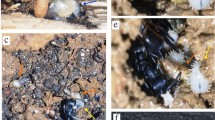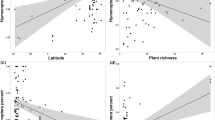Abstract
According to the “nectar protection” and “pollinator protection” hypotheses, ant repellents in flowers have evolved to prevent ants from exploiting floral nectar and chasing away pollinators, respectively. We used weaver ants, Oecophylla smaragdina, to determine the strength of ant repellence in 32 bee-pollinated plant species and used the comparative method to test whether nectar production, size of pollinating bees and plant growth form were related to floral repellence. Flowers were more likely to repel ants if they offered nectar as a reward and were pollinated by small bees than if they were nectarless and pollinated by large bees. Furthermore, tree flowers were more likely than shrub or vine flowers to repel ants. Our results validate the pollinator protection hypothesis and the nectar protection hypothesis. Depending on the ecological context, therefore, ant repellents can function as direct or indirect exploitation barriers: they can prevent ants from removing nectar without effecting pollination (direct barriers) and, when flowers are pollinated by large bees, the absence of ant repellents—or even the presence of ant attractants—can result in ants chasing small ineffective pollinators away (indirect barriers).


Similar content being viewed by others
References
Akaike H (1973) Information theory and an extension of the maximum likelihood principle. In: Petrov BN, Csaki F (eds) 2nd international symposium on information theory. Budapest, Akademia Kiado, pp 267–281
Ballantyne G, Willmer P (2012) Nectar theft and floral ant-repellence: a link between nectar volume and ant-repellent traits? PLoS ONE 7(8):10
Baroni Urbani C, de Andrade ML (1997) Pollen eating, storing, and spitting by ants. Naturwissenschaften 84(6):256–258
Bista S, Shivakoti K (2011) Honeybee flora at Kabre, Dolakha District. Nepal Agric Res J 4–5:18–25
Bluthgen N, Fiedler K (2004) Competition for composition: lessons from nectar-feeding ant communities. Ecology 85(6):1479–1485
Bremer B, Bremer K, Chase MW et al (2003) An update of the Angiosperm Phylogeny Group classification for the orders and families of flowering plants: APG II. Bot J Linn Soc 141(4):399–436
Burnham KP, Anderson DR, Huyvaert KP (2011) AIC model selection and multimodel inference in behavioral ecology: some background, observations, and comparisons. Behav Ecol Sociobiol 65(1):23–35
Corbet SA, Willmer PG (1980) Pollination of the yellow passionfruit—nectar, pollen and carpenter bees. J Agric Sci 95:655–666
Crozier RH, Newey PS, Schluns EA, Robson SKA (2010) A masterpiece of evolution—Oecophylla weaver ants (Hymenoptera: Formicidae). Myrmecol News 13:57–71
Davidson DW (1997) The role of resource imbalances in the evolutionary ecology of tropical arboreal ants. Biol J Linn Soc 61(2):153–181
Davidson DW, Cook SC, Snelling RR, Chua TH (2003) Explaining the abundance of ants in lowland tropical rainforest canopies. Science 300(5621):969–972
Dejean A, Corbara B, Orivel J, Leponce M (2007) Rainforest Canopy Ants: the implications of territoriality and predatory behavior. Funct Ecosyst Commun 1(2):105–120
Devall MS, Thien LB (1989) Factors influencing the reproductive success of Ipomoea pes-caprae (Convolvulaceae) around the Gulf of Mexico. Am J Bot 76(12):1821–1831
Devy MS, Davidar P (2003) Pollination systems of trees in Kakachi, a mid-elevation wet evergreen forest in Western Ghats, India. Am J Bot 90(4):650–657
Dulberger R (1981) The floral biology of Cassia didymobotrya and Cassia auriculata (Caesalpiniaceae). Am J Bot 68(10):1350–1360
Efloras (2008) Missouri Botanical Garden, St. Louis, MO and Harvard University Herbaria, Cambridge, MA. http://www.efloras.org. Accessed February 2014
Endress PK (1996) Diversity and evolutinary biology of tropical flowers. Cambridge University Press, Cambridge
Fiala B, Krebs SA, Barlow HS, Maschwitz U (1996) Interactions between the climber Thunbergia grandiflora, its pollinator Xylocopa latipes and the ant Dolichoderus thoracicus: the “nectar-thief hypothesis” refuted? Malay Nat J 50(1):1–14
Galen C (1999) Flowers and enemies: predation by nectar-thieving ants in relation to variation in floral form of an alpine wildflower, Polemonium viscosum. Oikos 85(3):426–434
Galen C, Cuba J (2001) Down the tube: pollinators, predators, and the evolution of flower shape in the alpine skypilot, Polemonium viscosum. Evolution 55(10):1963–1971
Ghazoul J (2001) Can floral repellents pre-empt potential ant-plant conflicts? Ecol Lett 4(4):295–299
Gómez JM, Zamora R (1992) Pollination by ants—consequences of the quantitative effects on a mutualistic system. Oecologia 91(3):410–418
Gómez JM, Zamora R, Hodar JA et al (1996) Experimental study of pollination by ants in Mediterranean high mountain and arid habitats. Oecologia 105(2):236–242
Gonzálvez FG, Rodríguez-Gironés MA (2013) Seeing is believing: information content and behavioural response to visual and chemical cues. Proc Biol Sci R Soc 280(1763):20130886
Gonzálvez FG, Santamaría L, Corlett RT et al (2013) Flowers attract weaver ants that deter less effective pollinators. J Ecol 101:78–85
Harley R (1991) The greasy pole syndrome. In: Huxley CR, Cutler DF (eds) Ant–plant interactions. Oxford University Press, Oxford, pp 430–433
Heard TA (1999) The role of stingless bees in crop pollination. Annu Rev Entomol 44:183–206
Inc StatSoft (2011) Electronic statistics textbook. StatSoft, Tulsa
Janzen DH (1966) Coevolution of mutualism between ants and Acacias in Central America. Evolution 20(3):249–275
Junker RR, Bluthgen N (2008) Floral scents repel potentially nectar-thieving ants. Evol Ecol Res 10(2):295–308
Junker RR, Chung YC, Bluthgen N (2007) Interaction between flowers, ants and pollinators: additional evidence for floral repellence against ants. Ecol Res 22(4):665–670
Junker RR, Daehler CC, Dotterl S et al (2011) Hawaiian ant-flower networks: nectar-thieving ants prefer undefended native over introduced plants with floral defenses. Ecol Monogr 81(2):295–311
Kato M (2000) Anthophilous insect community and plant–pollinator interactions on Amami Islands in the Ryukyu Archipelago, Japan. Contrib Biol Lab Kyoto Univ 29(2):157–254
Kato M, Kosaka Y, Kawakita A et al (2008) Plant–pollinator interactions in tropical monsoon forests in Southeast Asia. Am J Bot 95(11):1375–1394
Maddison WP, Maddison DR (2009) Mesquite: a modular system for evolutionary analysis. Version 2.75. http://mesquiteproject.org
Martins EP, Hansen TF (1997) Phylogenies and the comparative method: a general approach to incorporating phylogenetic information into the analysis of interspecific data. Am Nat 149(4):646–667
McDade LA, Daniel TF, Kiel CA (2008) Toward a comprehensive understanding of phylogenetic relationships among lineages of Acanthaceae s.l. (Lamiales). Am J Bot 95(9):1136–1152
Momose K, Yumoto T, Nagamitsu T et al (1998) Pollination biology in a lowland dipterocarp forest in Sarawak, Malaysia. I. Characteristics of the plant–pollinator community in a lowland dipterocarp forest. Am J Bot 85(10):1477–1501
Murali KS (1993) Differential reproductive success in Cassia fistula in different habitats—a case of pollinator limitation. Curr Sci 65(3):270–272
Nicklen EF, Wagner D (2006) Conflict resolution in an ant–plant interaction: Acacia constricta traits reduce ant cost to reproduction. Oecologia 148:81–87
Offenberg J, Havanon S, MacIntosh D et al (2004a) Observations on the ecology of weaver ants (Oecophylla smaragdina Fabricius) in a Thai mangrove ecosystem and their effect on herbivory of Rhizophora mucronata Lam. Biotropica 36:344–351
Offenberg J, Nielsen MG, MacIntosh DJ et al (2004b) Evidence that insect herbivores are deterred by ant pheromones. Proc R Soc Lond B 271:S433–S435
Pagel M (1999) Inferring the historical patterns of biological evolution. Nature 401(6756):877–884
Parker IM, Lopez I, Petersen JJ et al (2010) Domestication syndrome in Caimito (Chrysophyllum cainito L.): fruit and seed characteristics. Econ Bot 64(2):161–175
Pascarella JB (1997) Breeding systems of Ardisia Sw (Myrsinaceae). Brittonia 49(1):45–53
Punekar SA, Kumaran NKP, Bhat HR (2010) Observations on an unusual behaviour in the carpenter bee Xylocopa aestuans (Latreille, 1802) (Hymenoptera: Apidae) of the Wetern Ghats, India. J Threat Taxa 2(10):1232–1233
R Development Core Team (2010) R: a language and evironment for statistical computing. R Foundation for Statistical Computing, Vienna
Raine NE, Willmer P, Stone GN (2002) Spatial structuring and floral avoidance behavior prevent ant-pollinator conflict in a Mexican ant-acacia. Ecology 83(11):3086–3096
Raju AJS, Rao SP (2006) Nesting habits, floral resources and foraging ecology of large carpenter bees (Xylocopa latipes and Xylocopa pubescens) in India. Curr Sci 90(9):1210–1217
Reddi CS, Das RK, Aluri RJS, Aluri JB (1996) Sexual system and pollination ecology of Gmelina asiatica L. (Vervenaceae). J Palynol 32:41–50
Rodriguez-Girones MA, Santamaria L (2005) Resource partitioning among flower visitors and evolution of nectar concealment in multi-species communities. Proc R Soc B Biol Sci 272(1559):187–192
Rodríguez-Gironés MA, Gonzálvez FG, Llandres AL et al (2013) Possible role of weaver ants, Oecophylla smaragdina, in shaping plant–pollinator interactions in South-East Asia. J Ecol 101(4):1000–1006
Romero GQ, Antiqueira PAP, Koricheva J (2011) A meta-analysis of predation risk effects on pollinator behaviour. PLoS ONE 6(6):9
Schaeferhoff B, Fleischmann A, Fischer E et al (2010) Towards resolving Lamiales relationships: insights from rapidly evolving chloroplast sequences. BMC Evol Biol 10:352
Singh G (2004) Plant systematics: an integrated approach. Science Publishers Inc, New York
Siqueira de Castro M (2002) Bee fauna of some tropical and exotic fruits: potencial pollinators and their conservation. In: Kevan P, Fonseca VI (eds) Pollinating bees—the consevation link between agriculture and nature. Ministry of Envirinment, Brasilia
Thomas SG, Rehel SM, Varghese A et al (2009) Social bees and food plant associations in the Nilgiri Biosphere Reserve, India. Trop Ecol 50(1):79–88
Thompson JN (1982) Interaction and coevolution. Wiley, New York
Tsuji K, Hasyim A, Harlion, Nakamura K (2004) Asian weaver ants, Oecophylla smaragdina, and their repelling of pollinators. Ecol Res 19(6):669–673
Van Mele P, Vayssieres JF, Abandonon A et al (2009) Ant cues affect the oviposition behaviour of fruit flies (Diptera: Tephritidae) in Africa. Physiol Entomol 34:256–261
Willmer PG, Stone GN (1997) How aggressive ant-guards assist seed-set in Acacia flowers. Nature 388(6638):165–167
Willmer PG, Nuttman CV, Raine NE et al (2009) Floral volatiles controlling ant behaviour. Funct Ecol 23(5):888–900
Wojciechowski MF (2003) Reconstructing the phylogeny of legumes (Leguminosae): an early 21st century perpective. In: Klitgaard BB, Bruneau A (eds) Advances in legume systematics. Royal Botanic Gardens, Kew, pp 5–35
Wurdack KJ, Davis CC (2009) Malpiguiales phylogenetics: gaining ground on one of the most recalcitrant clades in the angiosperm tree of life. Am J Bot 96(8):1551–1570
Yamasaki E, Sakai S (2013) Wind and insect pollination (ambophily) of Mallotus spp. (Euphorbiaceae) in tropical and temperate forests. Aust J Bot 61(1):60–66
Yanoviak SP, Kaspari M (2000) Community structure and the habitat templet: ants in the tropical forest canopy and litter. Oikos 89(2):259–266
Acknowledgments
We thank Oriol Verdeny for assistance with the statistical analysis. Three anonymous reviewers made useful comments on an earlier version of this manuscript. This work was supported by the Ministerio de Ciencia e Innovación/FEDER (projects CGL2007-63223/BOS and CGL2010-16795 to MARG) and CSIC (studentship JAE-Pre_08_01008 to FGG).
Author information
Authors and Affiliations
Corresponding author
Electronic supplementary material
Below is the link to the electronic supplementary material.
Rights and permissions
About this article
Cite this article
Gonzálvez, F.G., Chen, J. & Rodríguez-Gironés, M.A. The function of ant repellence by flowers: testing the “nectar protection” and “pollinator protection” hypotheses. Evol Ecol 29, 391–403 (2015). https://doi.org/10.1007/s10682-014-9742-7
Received:
Accepted:
Published:
Issue Date:
DOI: https://doi.org/10.1007/s10682-014-9742-7




